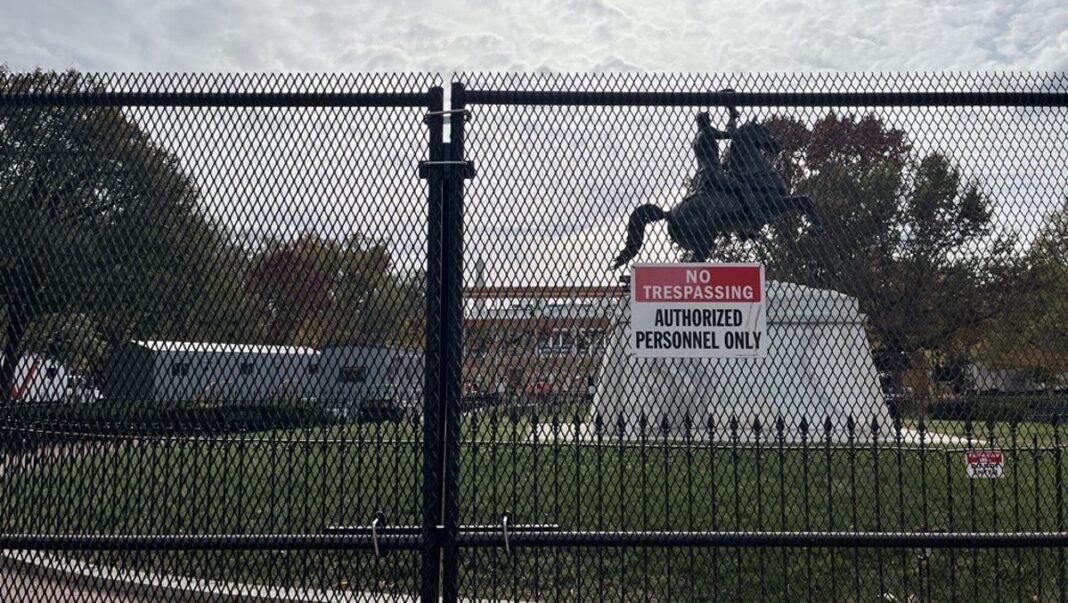The Fence Surrounding the White House Reflects Visitor and Voter Anxiety
At midday before Election Day, a typical mix of tourists, locals, and government employees enjoying their lunch break gathered in Lafayette Square, adjacent to the White House in Washington, D.C.
However, they encountered an unexpected sight: a robust, 10-foot-high metal fence now surrounded the White House, extending across the street and enclosing the bronze statue of former President Andrew Jackson on horseback at the park’s center.
The Secret Service’s choice to install this barrier right before Election Day left many visitors feeling frustrated and raised concerns among Americans about potential violence or disturbances in the capital during an intensely contested election.
“This is disappointing,” remarked Rose Jones, 77, who stood with her family at the heavy barrier. “The kids were excited to see the White House, and now they can’t even get a glimpse of it.”
Jones, hailing from North Carolina, was in Washington for a single day. She wasn’t alone in her surprise, as many visitors found the nation’s iconic residence inaccessible.
“We traveled so far to get here, and now it’s closed off,” expressed Alison Carrillo, 16, who visited with her family, including her parents, brother, and grandmother, for their first trip to the capital.
Following the violent events of January 6, 2021, when a mob attacked the Capitol in support of former President Trump, some understood the need for security measures. “It’s understandable that they are putting up barriers here,” she noted.
People filtered through limited openings in the outer fence along H St NW, while tourists attempted to capture photographs through the tightly spaced wires of the inner fence.
A Dark Sign for Democracy
For some, the presence of the fences felt ominous with the election approaching, an event already clouded by worries of violence.
“Seeing all these fences makes you wonder,” said Mike Longmeyer, 64, visiting Washington from Redlands, California.
Longmeyer, along with his wife Teresa Longmeyer, 61, expressed relief to be departing for home on Election Day morning, to avoid “any potential unrest.” He voiced that political divisiveness in recent elections has “spiraled out of control.”
“This isn’t what America should be,” he commented. “We should be fostering cooperation between parties instead of teetering on the brink of a civil conflict.”
The White House is not the only location preparing for potential Election Day chaos; several downtown businesses have reportedly boarded up their entrances, and a substantial fence has also been installed around the Naval Observatory, where Vice President Kamala Harris resides.
Metropolitan Police Chief Pamela Smith declared during a news briefing on Monday, “We will have no tolerance for violence in our city. There will be no acceptance of property destruction or threats to public safety and the electoral process.”
Washington Mayor Muriel Bowser expressed sadness about the current state of affairs, stating, “I feel very disheartened by these circumstances. However, I cope with anxiety through action and by ensuring we are as prepared as possible.”
Chief Smith indicated that the decision to erect the fences around the White House and Lafayette Square was made by the Secret Service.
Alexandria Worley, a spokesperson for the Secret Service, mentioned that additional fencing would also be installed around the Naval Observatory and the Palm Beach County Convention Center in Florida, where Trump’s campaign is set to monitor the election results.
“These security enhancements are not triggered by any specific threat but are part of comprehensive safety measures for Tuesday’s election,” Worley stated in her announcement.
A Foreign Perspective Amid Security Concerns
Nicolas LaPere, who plans to stay in Washington until after the election, made the trip from his hometown of Paris specifically to witness the occasion.
“It’s intriguing to experience a city on the brink of a presidential transition,” he observed. “We’ve come to appreciate it from a unique perspective.”
LaPere felt that Washington was laid-back. However, the fences around the White House hinted that this calmness might not last.
“Perhaps there are some worries in the city,” LaPere remarked. “It’s quite unusual.”
Along the stretch of Pennsylvania Avenue in front of the White House, a site typically accessible to the public, construction workers were present, surrounded by a tall wooden framework. A notice on the fence stated: “We apologize for the inconvenience. The District of Columbia, in partnership with the National Park Service, is building the 2025 Presidential Inaugural Parade Reviewing Stand.”
The tradition of constructing a reviewing stand dates back to a simple wooden platform covered with canvas where Abraham Lincoln stood in 1861 to observe over 20,000 troops preparing for battle during the Civil War, as reported by the White House Historical Association.
‘Concerning’
Some visitors viewed the situation differently—adopting a cautious approach was wiser.
“It’s a sensible move,” stated Angel Perez, who traveled an hour from Maryland to explore Washington’s sites. “There are some unstable individuals out there, so it’s probably safer to keep everyone restricted.”
Nonetheless, Perez found the presence of the barriers “concerning.” “We took a photo here two years ago, right in front of the White House, which was pretty neat. But this is something we’ve never encountered before,” he noted.
Longmeyer expressed that he and his partner strolled for a few miles around the White House to catch a better glimpse but ultimately decided to abandon their efforts.
“I came to see the White House, and I think I’ve only glimpsed a corner of it,” he commented. “Taxpayers fund this. You can hardly even see it.”

